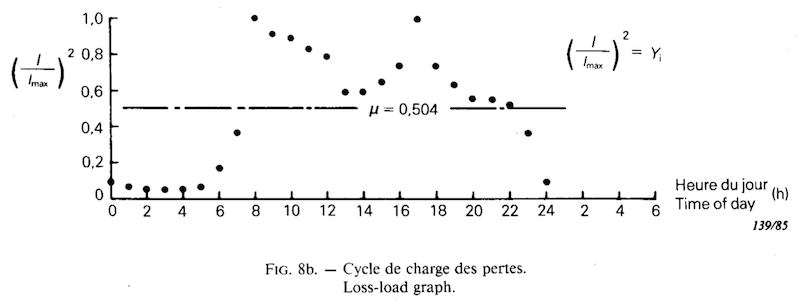The loss factor is the ratio between the average power losses (energy losses) and the losses during peak load in a period of time. In other words, the loss factor is simply the load factor of the losses. There are two methods to calculate the loss factor:
For the Neher McGrath, Heinhold and the Dorison method, the power and energy losses are not obtained from directy measurements. Their estimations are based on previous knowledge of their own loss factors. The loads present nearly constant power factor, and express both the demand and energy in p.u. of their respective maximum values. Thus, the loss factor can be expressed in relation to the demand. The consumer diversity and the different consumer behaviours in areas with different geographical and socioeconomic characteristics has an influence on the loss factor. The loss factor could be obtained by using the load curves of all customers which is not viable. Based on measurement campaigns, characteristic curves for consumers separated by groups (e.g. tariff groups) are obtained. The technical losses in the systems can be divided in two large groups: independent (constant) losses of the load like losses in the transformer cores with with $\mu$ = 1 and the depended (variable) losses of the load such as ohmic losses with $\mu$ < 1. All the studies in the search for a relationship between the loss and the load factor led to the same empiric equation below (first equation).
For transient calculations acc. IEC 60853 (CIGRE), the loss factor is determined by decomposing the load cycle over 24 hours into hourly rectangular pulses. The loss factor may also be calculated through summation of weighted measurement values over the past 24 hours.
For convenience, Cableizer does also allow longer durations $i_{max}$ than 24 hours for the loss factor calculation. If the duration $i_{max}$ is shorter than 24 hours, Cableizer does assume that the power losses prior to the first provided value were constant at the same level as the first provided value. The same is also the case if the duration $i_{max}$ is not a multiple of a full hour.
| $k_{LF} LF+\left(1-k_{LF}\right) {LF}^2$ | Neher McGrath, Heinhold, Dorison |
| $\frac{1}{i_{max}} \sum_{i=0}^{i_{max}} Y_i$ | IEC 60853 (CIGRE) |
| ${LF}^2$ | Heinhold |

IEC standard 60853-2 Ed. 1.0 (1989) Figure 8b